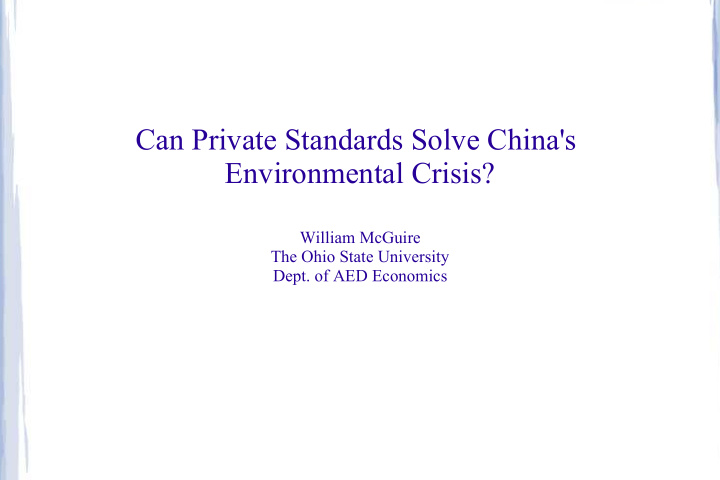



Can Private Standards Solve China's Environmental Crisis? William McGuire The Ohio State University Dept. of AED Economics
A Role for Voluntary Standards? ● China has earned reputation for putting development ahead of sustainability ● Under voluntary programs, firms can be motivated to over-comply with environmental regulations – Lower threat of future regulation (Lyon and Maxwell, 2003) – Earn price premium in the output market (Eriksson, 2004)
Why are Voluntary Standards Necessary? $ $ MPC MAC A MAC B MAC C MP MAC Pollution G A (2G+A) ● Emissions generally controlled with quantitative standards enforced by penalties (Beyer, 2006)
Room for Improvement $ $ MPC MAC A MAC B MAC C MP MAC MAC G A (2G+A) ● Potential Pareto improvements exist if standard is violated or set too high
Negotiating Over-Compliance $ $ MPC MAC A MAC B MAC C P* MAC Pollution C G A (A+G+C) ● Firms and consumers negotiate an effective payment for emissions reductions in the output market
Information Asymmetry in Output Markets ● Firms' emissions are credence attributes of products in the output market – Adverse selection: Firms with high MAC's may misrepresent their type to attract “green” consumers – Moral hazard: Consumers must be sure clean firms follow through on emissions reductions
ISO 14000 ● ISO 14000 is the most popular voluntary environmental program in the world (~39,000 in China) – Regarded as a globally viable alternative to command and control regulation ● Employs third-party certification (14001) of firm environmental management system (EMS) – ISO 14001 reveals firm abatement technology but not emissions levels
How Can ISO 14000 Address China's Environmental Crisis? ● What motivates ISO 14001 certification among Chinese firms? ● Can ISO 14001 help China overcome regulatory shortcomings? – Is cost/complexity a barrier to adopting ISO 14001? – How can ISO 14001 resolve the asymmetric information problem when it does not signal emissions levels?
The Evidence So Far ● Adoption closely related to customer type (Nishitani, 2010; Curcovik et al., 2005) – Helps exporting firms reach foreign markets (Christmann and Taylor, 2001; Prakash and Potoski, 2005) – Assumed to match clean firms and green consumers ● Evidence on ISO 14001 and emissions reduction is mixed (Potoski and Prakash, 2005 vs. Barla, 2007
Empirical Strategy ● Estimate determinants of adoption to interpret firm motivations ● Estimate two logit models (King et al., 2005): – Does the firm have an EMS (environmental protection department)? – Is the firm ISO 14001 certified, conditional on having an EMS? ● Isolate the role of certification
Data ● Enterprise survey on corporate social responsibility conducted by IFC + NBS in 2006 ● Total of 1,264 respondents from 12 different cities across China – Information on firm's environmental activities including ISO 14001 certification and other management practices – Largely cross-sectional
Firm Characteristics Environmental ISO 14001 Protection Department (1) (2) (3) (4) (1) (2) (3) (4) 1.02 c Firm Age 1.02 1.02 1.02 1.00 1.01 1.01 1.01 (1.51) (1.69) (1.53) (1.53) (0.11) (0.54) (0.73) (0.61) 1.00 b 1.00 b 1.00 b 1.00 b Average Employment 1.00 1.00 1.00 1.00 (2.23) (2.14) (2.16) (2.17) (1.31) (0.85) (0.71) (0.88) 1.00 b 1.00 b 1.00 b 1.00 b Average Employment^2 1.00 1.00 1.00 1.00 (-2.14) (-2.00) (-2.00) (-2.04) (-1.08) (-0.54) (-0.44) (-0.49) Management College Edu (60%+) 2.28 a 2.32 a 2.40 a 2.26 a 0.76 0.77 0.78 0.85 (3.03) (3.06) (3.17) (3.91) (-0.71) (-0.67) (-0.62) (-0.42) ● Firm characteristics like size and human capital are important for EMS adoption, not certification – Certification costs may be relatively small
Regulatory Environment Environmental ISO 14001 Protection Department (1) (2) (3) (4) (1) (2) (3) (4) 2.84 b 2.78 b 2.64 b 2.58 c Gov't Inspections: 10+ /year 0.92 0.86 0.86 0.80 (2.18) (2.12) (2.01) (1.92) (-0.15) (-0.26) (-0.26) (-0.26) Gov't Inspections: Weak 0.51 c 0.49 b 0.50 b 4.44 a 4.12 a 4.26 a (-1.89) (-2.04) (-1.97) (2.68) (3.63) (2.57) Gov't Inspections: Not Effective 0.23 a 2.09 (-2.94) (0.79) # Applicable Gov't Standards 1.34 a 1.32 a 1.32 a 1.32 a 1.51 b 1.42 b 1.36 c 1.42 b (4.79) (4.40) (4.37) (4.22) (2.16) (1.83) (1.70) (1.97) ● Firms certify ISO 14001 where regulation is ineffective – Greater gains from negotiating abatement in output market
Potential Gains Under Weak Enforcement $ $ MPC MAC A MAC B MAC C E(MP) MAC Q G C B A (2G+A) (A+B+C) ● Poor enforcement of regulations encourages firms to rationally violate the standard
Market Environment Environmental ISO 14001 Protection Department (1) (2) (3) (4) (1) (2) (3) (4) 2.20 c Largest Customer: Foreign 1.12 1.02 1.04 0.95 1.85 1.61 1.76 (0.41) (0.08) (0.15) (-0.20) (1.81) (1.38) (1.07) (1.22) 1.72 b 1.70 b 2.61 c 2.84 b Customer Environmental Standard 1.48 0.24 (2.26) (2.20) (0.86) (1.89) (2.00) (-1.45) Customer Quality Inspections 1.57 0.09 b (1.06) (-2.49) CESxCQI 1.22 20.03 a (0.38) (2.60) ● ISO 14001 response to demands for environmental protection from customers ● Ex-post monitoring is strongly complementary
Conclusions ● ISO 14001 matches clean firms with green consumers in the output market – Direct costs of certification appear low, but may also require costly ex-post monitoring – Can also substitute for effective environmental regulation ● More theoretical work is needed to compare ISO 14001 or similar programs to regulatory instruments
Recommend
More recommend